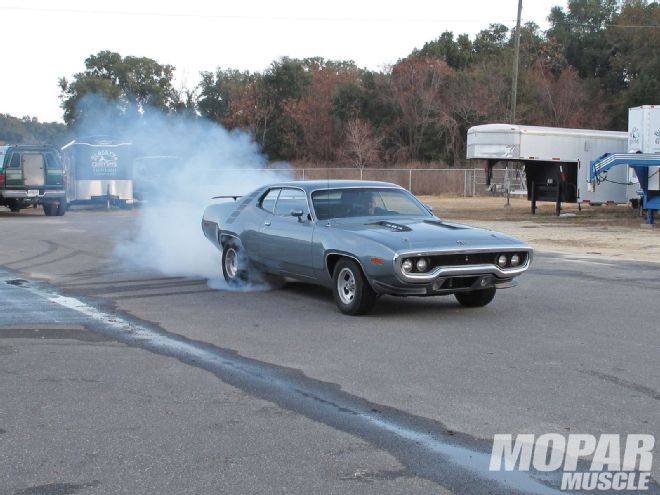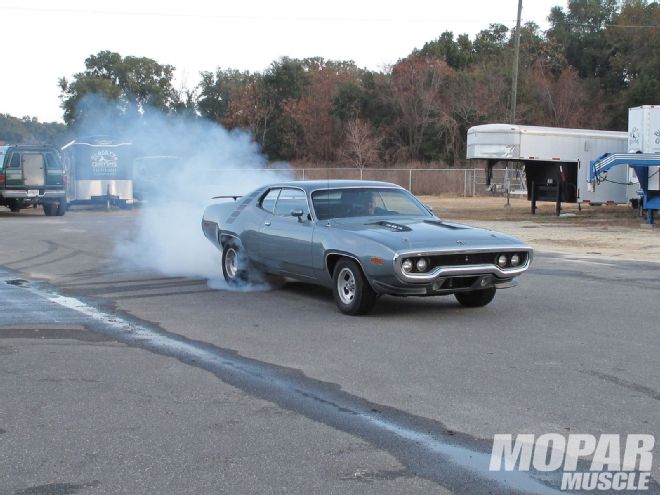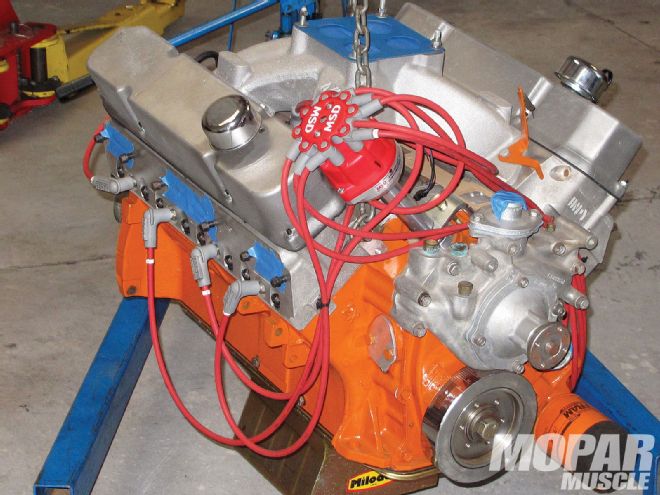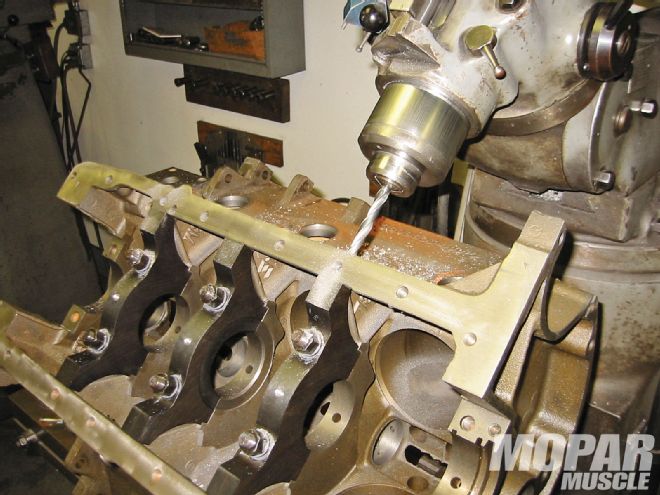
With all the talk about Mopar small-blocks during the 2010 AMSOIL/Mopar Muscle Engine Challenge, we didn't want our big-block followers to feel left out, so we thought we'd let you follow along on an engine we're building for one of our own Mopars. Those of you who read Mopar Muscle magazine regularly will recognize this car as a '71 Road Runner we picked up from friend Dale Mathews in North Carolina. Since we purchased this car sans the original engine, it's perfect for a swap to a brawnier big-block that will turn heads at cruise night and run impressive elapsed times at the dragstrip. So far we've painted the car, restored the interior, and installed all new suspension, brakes, and rear differential in previous articles. To get the car moving under its own power, we also installed a warmed over 383. While this engine runs fine, it's basically stock and doesn't really satisfy our need for power. This month, we'll tell how we decided which powerplant to build for this car, and show you all the parts and techniques we used to accomplish the job.
 When we decided more power was in order for our '71 Road Runner, we considered our options, deciding a low-deck big-block best fit the purpose of this build.
When we decided more power was in order for our '71 Road Runner, we considered our options, deciding a low-deck big-block best fit the purpose of this build.
Noting that the low-deck B engines that used 440 crankshafts in our 2009 engine challenge made impressive power using a bunch of factory parts, we decided that in the interest of a tight budget we'd follow this theme with this engine as well. Of course it helped our decision that we had a pretty clean 400 block sitting in the shop along with a factory forged 440 crankshaft, not to mention the 400 will bolt right in place of our car's 383, making for an easy swap. Using the parts you have around the shop certainly makes sense whether you're on a budget or not, as it cleans the shop and puts to use items that were just sitting around. We were lucky, since our 400 block and 440 crank form the basis for a powerful and economical Mopar big-block.
 This month we'll show you the parts and techniques we used to build the engine, and look for dyno and track testing in later issues.
This month we'll show you the parts and techniques we used to build the engine, and look for dyno and track testing in later issues.
Knowing we'd need aftermarket forged pistons and connecting rods for this engine, we called 440 Source to check out our options. 440 Source has plenty of stroker kits available for big-block Mopars, and their prices are hard to beat whether you need an entire balanced rotating assembly or an individual engine part. Since we already had a factory forged crankshaft, we didn't need an entire rotating assembly, opting for a set of their forged H-beam 6.76-inch connecting rods and a set of forged, flat-top pistons which will give us a compression ratio of just over 11:1. Priced right, these pieces from 440 Source are rated to 1,000 horsepower, so they will be plenty tough for our street engine.
 Back in the December 2010 issue, we showed you how Auto Performance Engines (APE) machined this block for Pro-Gram Engineering four-bolt main caps. These caps are billet steel, and really strengthen the bottom end with the additional bolts cross-bolting the caps in place.
Back in the December 2010 issue, we showed you how Auto Performance Engines (APE) machined this block for Pro-Gram Engineering four-bolt main caps. These caps are billet steel, and really strengthen the bottom end with the additional bolts cross-bolting the caps in place.
With the major pieces of our bottom end in place, we took the parts to Auto Performance Engines to be machined, and ordered our Clevite bearings, Speed Pro piston rings, and Fel-Pro gaskets from Summit Racing Equipment, along with a new Melling high-volume oil pump. For a street engine of this type, internal oiling is adequate so long as you upgrade the system, which we did by machining the block for a larger 1/2-inch diameter Milodon pick-up, and installing a Milodon 7-quart oil pan with a factory windage tray.
Experience tells us that low-deck stroker motors of the type we're building make plenty of power, as even 906 headed versions can make upward of 550 horsepower and a bunch of torque. The common technique is to bore the 400 block to 4.380 inches, then either turn the main journals of the crank down, or line-bore the main journals of the block for the larger 440 crankshaft, giving a total displacement of just over 451 cubic inches. We chose to have Kevin at APE turn our crankshaft to the 400 main journal size, then clearance the weights to clear the block and balance the rotating assembly. APE also bored our block to accommodate our 440 Source forged pistons, and installed Pro-Gram Engineering's forged, cross-bolted main caps to strengthen the bottom end. With the makings of a stout short-block underway, we knew the only way to top this was with a set of good-flowing aftermarket cylinder heads. To put our big-block over the top, we chose a proven performance package from Indy Cylinder Head-their 440-1 kit.
We've used these and other Indy heads before on big-block Mopar engines, and we know they offer impressive flow numbers, especially when ported, resulting in big power. The raised port design of the 440-1 head requires valves with longer stems, external rocker oiling, and specially offset rocker arms, but luckily Indy offers a kit that gives you everything you need between the carburetor and the block, including the assembled heads, valve covers, intake manifold, rockers, oiling kit, and pushrods. Even better, Indy's price for this kit has changed very little over the past years, making it especially affordable in today's economy. In addition to the basic kit, we had our heads CNC ported by Indy, and we also had them install roller valvesprings from Comp Cams. For the best combustion chamber seal, we had these heads O-ringed and will install them with copper head gaskets from Summit Racing. The only drawback of the Indy heads is that their raised exhaust ports require the use of special headers. Fortunately TTI makes just the part number we needed, so we called and ordered a set of their mandrel-bent, coated, step headers for our application.
Knowing the heart of a performance engine is its camshaft, we picked a solid roller camshaft from Comp Cams. Despite what you may have heard, there's really no reason you can't run solid lifters in a street engine. Comp has less aggressive camshaft lobes that are designed specifically for street use and don't sacrifice power or throttle response like a hydraulic cam and lifter setup. We called Comp's cam help line, and after giving them the specifics of our application, we chose a solid roller cam with a total valve lift of .660 inch. Die hard racers will no doubt write in to say we need over .700-inch lift to maximize this combination, but remember this is a street engine and we don't want to wear out valvesprings any quicker than necessary. Even with this moderate roller cam, this engine should make plenty of power for a B-body that will be limited to street tires. To spin the cam, we ordered one of Comp's billet, adjustable, double roller timing sets with a Torrington style thrust bearing. Though not their least expensive timing set, this is an area where we just don't want to sacrifice because it's not significantly more expensive to buy the best parts.
So follow along as we build this stout, but moderately priced big-block for our '71 Road Runner. We'll show you all the parts and procedures we used to assemble this engine this month, and be sure to watch future issues as we'll upgrade the car's fuel and ignition system, install some safety equipment, then install the engine and run the car both on the chassis dyno and at the dragstrip. Log onto moparmusclemagazine.com as well for exclusive video and to tell us what you think of our combination.